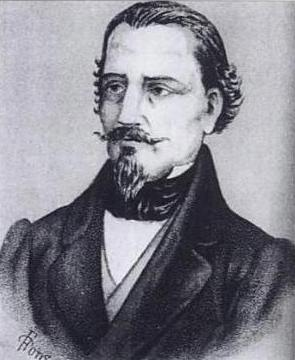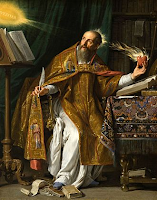George Garden 1649-1733 Episcopalian Minister Church of Scotland Wiki , DNB The course of events prior to prosecution George Garden was ordained by Bishop Scougall in 1677 as a priest in the Scottish Episcopal Church. He succeeded his father as minister of the church at Forgue in Aberdeenshire [ Wiki ] in 1674 and, in 1679, he was appointed to the church of St Machar, Aberdeen, the city's Cathedral, from which, in November 1683, he moved to the church of St. Nicholas, also in Aberdeen. By this point he was also a Doctor of Divinity. The gatehouses to St Macher, Aberdeen In the words of the supposed old Chinese curse, he was doomed to live in interesting times. (Though the phrase could be from Yorkshire - here ). The Revolution of 1688, and the institution of the presbyterian Church of Scotland as the State church, was not to Garden's liking. 1692 he was deposed from his post by the Scottish Privy Council for 'not praying for their Majesties, William and Mary.'...
Posts
Cayetano Ripoll, hanged for heresy
- Get link
- X
- Other Apps

This account does not fit within the parameters of my study of heresy in Britain and Ireland. I include it nonetheless as a salutary example of what has been done by Christians who were convinced of their own righteousness. =========== Cayetano Ripoll (1778-1826) was a schoolmaster, a soldier in the Spanish Peninsular War, a Deist and very unfortunate: he was the last person to be killed by the Spanish Inquisition. ( Wiki has a fuller account.) The Inquisition had been suppressed in Spain in 1808. It was reconstituted under King Fernando VII in 1814 and the following year it issued an edict condemning modern rationalist philosophy and calling on all faithful Catholics to denounce anyone who adhered to such teaching, as well as Jews, Muslims and Protestants. Ripoll, when a soldier, had been captured by French forces and imprisoned. Whilst there he declared himself to be a Deist. (Caytano Ripoll. Image from the World Union of Deists.) On his return to Valencia i...
R.W. Seaver, Belfast, 1927
- Get link
- X
- Other Apps

This case is firmly at the trivial end of the spectrum of heresy cases. Yet it has one feature which I think may be unique: the accusation of heresy came from a member of a different denomination - an Anglican was accused of heresy by a Presbyterian. In theory this would seem to imply that the accuser (a) held the view that the Christian faith was both uniform and universal - at the very least in its essentials, and (b) that there was an implicit duty or responsibility placed on some church leaders to monitor and police the boundaries of orthodoxy in other churches. In practice the motivation was probably more about the power dynamics within the presbyterian church concerned. Press reports are fairly scanty and I have not found any statement from the accuser, so can only speculate as to the events and thinking which eventuated in the accusation. _________________ The Rev. R.W. Seaver was the Church of England Rector of St John's Church, Malone Road, Belfast. ( Wiki [stub])...
What heresy is, according to Opera Augustine, and me
- Get link
- X
- Other Apps

Every so often a dcument called "What is heresy?" by Opera Augustine is brought to my attention, such is the way of automated programmes telling me what I am interested in. Opera Augustine is Roman Catholic, probably (though I am not conversant with the shadings of RC adherence) of a central-conservative disposition. Perhaps 'traditionalist' would be a fair description. I am happy to be corrected. I put this first because his comment on heresy remains within the bounds of the Roman Catholic Church. His statement is universal but its application is local. St. Augustine by Phillipe de Champagne ( Wiki ) Heresy He begins "Heresy is an emotionally loaded term that is often misused." yet he offers no evidence to support either part of this assertion. He tells us some uncontroversial things that heresy is not and then cites the Roman Catechism: "Heresy is the obstinate post-baptismal denial of some truth which must be believed with divine and Catholic fai...
Peter Williams, 1773
- Get link
- X
- Other Apps
In the 1560s a theological division between John Calvin and Jacobus Arminius set reverberations in the then nascent Protestantism that have continued to echo through history. (They didn't meet: Calvin died in 1564 when Arminius was just four years old.) Simplistically, Calvin taught that God had predetermined the spiritual destination - whether to heaven or to hell - of every person ( Wiki ). Arminius taught that Calvin's view 'made God the author of evil'. He asserted, to the contrary, that God gave people a choice between damnation and salvation. ( Wiki ). By the time of our putative heretic these twin tracks had cut deep grooves in church history. Charles Wesley, the Methodist leader, was firmly Arminian with his evangelical emphasis on individual choice. In 1745 Peter Williams was ordained deacon in the Church of England (which then encompassed Wales). He served as curate in Eglwys Gymyn, Swansea, Llangrannog, and Llandysilio Gogo. His affinity with Methodism ...
Frances Stone, 1809
- Get link
- X
- Other Apps
Francis Stone In 1809 Francis Stone, Rector of Cold Norton in Essex, was tried for heresy. He had been educated at Charterhouse School and, from the age of 16, University College, Oxford (1755-1759). In 1760 he was Curate to a relative, Rev Thomas Hunt, at Crawley in Hampshire where he became an Arian. In 1762 he moved to be curate in Worth, Hampshire, and from there to be Rector of St Stephen's Church, Cold Norton, Essex in 1765. [ Biography , Cold Norton Church - the building is later than Stone's day.] Stone had been a fairly prominent supporter of lost causes and a gadfly to those in authority since the 1760s. He espoused liberal theology, and reform in the church based on a critical opinion of the relationship between Church and State. And what he thought, he published. In 1768, in the good company of Benjamin Hoadly, Bishop of Winchester ( wiki ), the Unitarian Theophilus Lindsay ( wiki ) and others, Stone had been a leading advocate of the Feathers Tavern petition ...